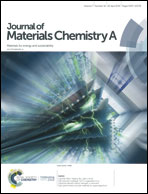Asymmetric superwetting configuration of Janus membranes based on thiol–ene clickable silane nanospheres enabling on-demand and energy-efficient oil–water remediation†
Abstract
Emerging Janus membranes have attracted widespread attention as next-generation separation materials due to the synergistic effect triggered by the asymmetric wettability; however, they are challenged by a complex fabrication, unalterable substrate selection and insufficient on-demand liquid phase separation. Herein, thiol–ene click chemistry was first introduced as a versatile and reliable platform for specific Janus membrane manufacturing. The photoactive layer containing clickable silane nanospheres could be deposited on various surfaces via the hydrolysis and polycondensation of trichlorovinylsilane (TCVS), followed by tailoring wettability in the presence of directional UV irradiation, which imparted any target substrate with designed asymmetric performance. As a proof-of-concept, Janus membranes with relatively large aperture could accomplish the on-demand separation of immiscible oil/water mixtures, involving different oil densities according to the corresponding wetting behavior on both sides, whereas Janus membranes with smaller aperture could well separate surfactant-stabilized emulsions whether oil-in-water or water-in-oil type. Notably, the controllable processes showed both superior separation efficiency and prominent long-term durability, which is of great significance for multiple oil–water remediation in modern industrial fields as well as providing feasibilities for other wettability-oriented applications, including lab-on-a-chip microfluidics, intelligent sensors and interfacial microreactors.



 Please wait while we load your content...
Please wait while we load your content...